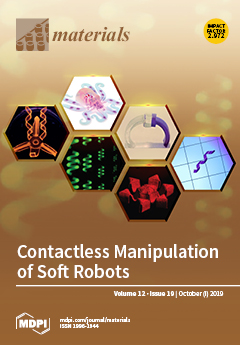The results of the position analysis of the yield stress τ
0.3 on the "stress–strain" (τ–γ) dependences, received at the torsion of specimens of Ti
49.8Ni
50.2 (at%) alloy are presented. The critical stress τ
0.3 (IV), corresponding to the end of
[...] Read more.
The results of the position analysis of the yield stress τ
0.3 on the "stress–strain" (τ–γ) dependences, received at the torsion of specimens of Ti
49.8Ni
50.2 (at%) alloy are presented. The critical stress τ
0.3 (IV), corresponding to the end of linear stage III and the beginning of the intensive development of plastic strain at stage IV, preceding the fracture of the specimens, were obtained as well. The structure of the specimens was transformed from coarse-grained to microcrystalline as a result of warm (723 K) abc pressing with a true deformation
e of 8.4. The regularities of the development of reversible inelastic strain (superelasticity, SE, and shape memory effect, SME) and plastic strain γ
pl after isothermal (295 K) loading of specimens up to τ ≤ τ
0.3(IV), unloading, and their subsequent heating up to 500 K are studied. From the joint analysis of the “τ–γ” dependences obtained at 295 K and "plastic strain–total strain" dependences the yield stress τ
0.3 corresponding to the development of 0.3% of the plastic strain under loading of the specimens was determined. Critical stress τ
0.3(IV) was determined as equal to the stress corresponding to a deviation of 0.3% from the linear “τ–γ”dependence at stage III. It is shown that the yield stress τ
0.3 for all specimens is localized at the beginning of stage III for all specimens. The ratio τ
0.3(IV)/τ
0.3 is from 2.3 to 3.8. The accumulation of plastic strain at stage III (after loading with τ from τ
0.3 to τ
0.3(IV)) is from 2.4% to 4.7% (depending on the true deformation of the specimens during warm abc pressing). Thus, stage III is the stage of deformation hardening of specimens under torsion. On the basis of the results of this and previous works it is shown that, in alloys with thermoelastic martensitic transformations and with thermomechanical memory, the ratio τ
0.3(IV)/τ
0.3 can vary in a wide range: in reinforced specimens τ
0.3 can be close to τ
0.3(IV), and in more ductile specimens τ
0.3 can be significantly less than τ
0.3(IV). However, in order to correctly determine the yield stress of τ
0.3 and the corresponding strain γ
t(0.3), it is necessary to carry out a joint analysis of “τ–γ” and "plastic strain–total strain" dependencies.
Full article






